by Winding Pathways | Jul 3, 2025 | (Sub)Urban Homesteading, Flowers/Grasses, Foraging, Garden/Yard, Pests
A Variation on “The Four Horsemen”
A quartet of deadly and toxic plants lurks along trails and riverbanks in Iowa and some across much of the world. They are Poison Hemlock, Poison Ivy, Flowering Spurge, and Wild Four O’clock.
Poison Hemlock
We’ll start with Poison Hemlock. Socrates wasn’t the only person killed by it. The Greeks once used to execute criminals.
Poison hemlock isn’t related to the majestic hemlock tree. Rather, it’s a biennial herbaceous plant. In its second year it quickly shoots up to tower upwards of eight feet tall. In Iowa it prefers living in dappled sunlight where the soil is moist. That describes the land bisected by public trails paralleling rivers and streams—places where people go to recreate.
It’s deadly poisonous, but only when ingested. Walking or cycling by it creates no problem at all. But it’s wise to know about this potentially deadly plant. All parts of it are toxic to people and animals when ingested. Even dried, wintery stems are poisonous.
By early June, the tall green plants with feathery leaves begin bearing white clusters of flowers. Their prettiness is deadly.
Poison hemlock could be confused with Queen Anne’s Lace that’s sometimes called wild carrot. Poison hemlock also often lives near wild parsnips. This plant is also toxic, in a different way. It can create a vicious rash in people who rub against it with bare skin and then are exposed to sunlight.
Where Poison Hemlock Originated
Poison Hemlock is native to Europe and is especially common around the Mediterranean Sea. It was introduced to the Americas, New Zealand, Australia, and Asia, so today, it is a toxic invasive species worldwide.
The Internet and YouTube are loaded with sites describing this plant. A good quick read comes from the National Park Service at nps.gov/articles/poison-hemlock.htm.
Other Troublesome Plants
Unfortunately, several other deadly and toxic plants often live in the same places as poison hemlock. Here are a few.
- Poison ivy often lines trails. It prefers living on the edge of woodlands where it gets some shade and sun. Unlike poison hemlock, poison ivy is a native plant that causes a contact reaction. That means if human skin brushes against it a nasty itchy rash can follow. And, if a pet wanders through the poison ivy and then comes inside where a human pats it, guess what? The irritating oils are transferred and the human gets a nasty rash. A friend of our discovered this earlier this year. Also, state parks are notorious for having poison ivy growing where people contact it – along unkempt trails and winding up trees in campgrounds even. Rabbits and deer eat it and birds eat and spread the seeds.
-
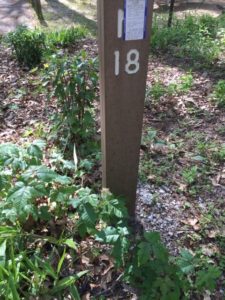
-
Birds drop seeds when they perch on campground posts.
-
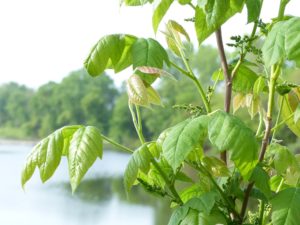
-
Poison Ivy loves edges
-
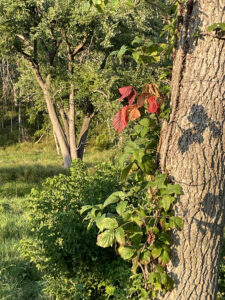
-
Keep your distance from this beguiling, colorful plant.
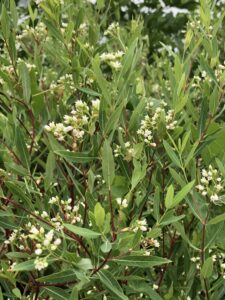
Pretty and irritating
Flowering spurge is also common along trails. Cut the plant and get some of its sap on skin and a nasty welt is likely to result.
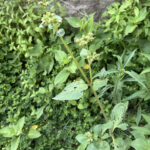
Unattended areas attract undesirable plants.
Wild Four O’clock also loves trail edges and is reported to be toxic.
None of these plants cause problems unless they are eaten or contact the skin. They won’t cause a problem for anyone just walking by
Be careful. Keep your distance.
by Winding Pathways | Jun 19, 2025 | (Sub)Urban Homesteading, Flowers/Grasses, Garden/Yard, Garden/Yard
Years ago, anyone attempting to create a diverse, native landscape in their yard sometimes experienced weed ordinance woes. Their local ‘weed commissioner” would order them to mow their “messy” yard.
Towns created ordinances to give them the authority to force landowners to remove what was perceived to be health or safety hazards. But, they were sometimes used to enforce conformity to the standard of neatly mowed, sprayed, monoculture lawns promoted by lawn product and care companies.
Cities do need the authority to deal with situations where landowners simply neglect their yards by not mowing, but they should not be able to use ordinances to enforce an aesthetic standard.
Changing Times – Responding to Declining Pollinator Populations
These days, homeowners everywhere recognize the importance of diversity. They are creating diverse landscapes of native plants even in tiny yards. Towns are responding by altering restrictive ordinances to allow the restoration of beautiful vegetation that supports beneficial wildlife, including pollinators.
Anyone who plans to diversify their yard in a way that makes it look different from their neighbors’ runs a risk of running afoul of their local town’s ordinance.
Guidelines To Reduce Neighbor or Municipal Friction.
- Research your town’s weed ordinance. Often, it’s printed on the town’s website.
- Develop a written plan and diagram of what the yard will become. It doesn’t need to be fancy or detailed.
- Cultivate and educate neighbors. Even towns that have old-fashioned ordinances rarely go out of their way to enforce them. Enforcement is triggered by complaints, usually from neighbors. Sharing a yard’s plan with neighbors before the change takes place may help them understand that what you are doing isn’t neglect.
- Start small. Maybe just replace a corner of a yard with prairie the first year and expand it gradually as the years go by.
- Make the yard look tended and not neglected. This can mean mowing pathways through tall grass, maintaining some lawns, and often being seen tending the yard tending the landscape.
- Avoid health or safety hazards. Avoid planting taller vegetation that will block a driver’s vision at intersections. Don’t allow allergens like poison ivy or ragweed to grow.
- Hiring a knowledgeable professional yard care company to plan and implement diversity.
Results
Restoring a gorgeous landscape of native vegetation is a delightful project that makes our world a bit healthier. Doing so is easier if it doesn’t irritate neighbors or invoke a stern town ordinance.
-
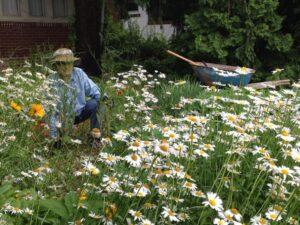
-
Native and cultivated plants brighten a front yard.
-
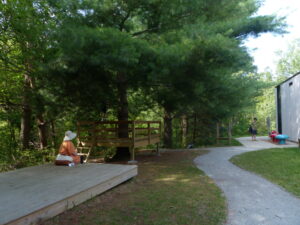
-
Families outside
-
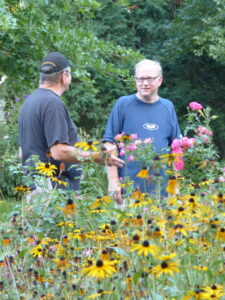
-
Converting a yard to more natural plants brings joy.
This first appeared on the Sustainable Landscape Solutions Website at sustainable landscape solutions.org. The company is based in Iowa City, Iowa, and helps landowners create wondrous yards.
by Winding Pathways | May 1, 2025 | Birds, Flowers/Grasses, Nature
A woodland stroll is outstanding in any season but is best during May’s first ten days. We always marvel at nature’s fleeting changes that happen swiftly.
Why Early May
Late April and early May are when ephemeral flowers revel in their time in the sun. That long word “ephemeral” means a short time. There’s a brief time in late April through about mid-May when the air and soil are warm but trees haven’t yet leafed out. So, sunlight streams through still naked branches to reach the ground.
Bloodroot, trout lily, anemone, Dutchman’s breeches, ginger, trillium, and May apples, among many of the woodland flowers, take advantage of this window of sunshine. They grow amazingly fast, bloom for a short time, and then seem to disappear for the rest of the year. They are there but hard to see and not in bloom during summer’s heat and winter’s chill.
-
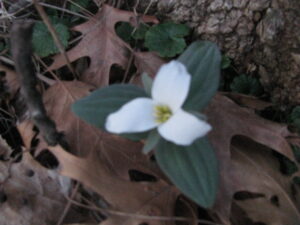
-
An early bloomer
-
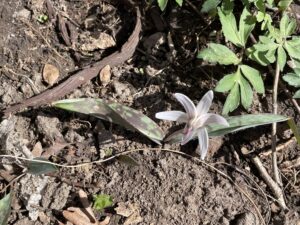
-
Trout Lily can form carpets in dappled shade.
-
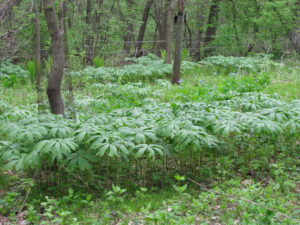
-
Mayapples carpet the forest floor.
-
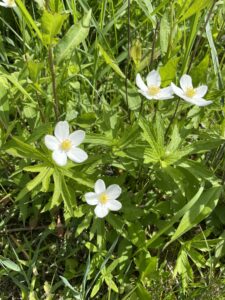
-
A sunny center surrounded by white petals.
-
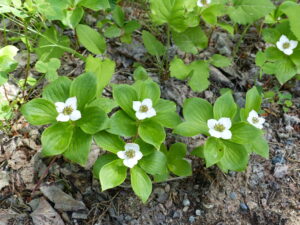
-
Bunchberry forms a lush, carpet on moist soils.
-
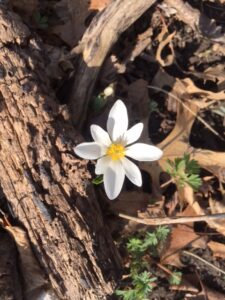
-
When broken, the stem oozes a reddish sap.
Other Delights
Enjoying wildflowers is only one of early May’s woodland delights. Another is birds.
Many of them are, like wildflowers, ephemeral but in a different way. They are migrants en route from points way south to breeding areas up north. For only a few days, often in early May, they linger to feed, rest, and sing before continuing their journey.
We always look forward to seeing migrating birds on their way north and others that come north to nest near our home. Flowers are easy to find. They can’t hide. Birds can, and often many fascinating birds are hard to spot but easy to hear as they sing in what seems like springtime joy.
-
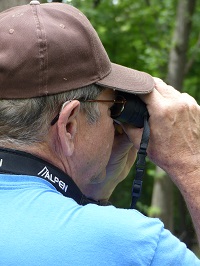
-
Bird watching is again a joy with hearing aids.
-
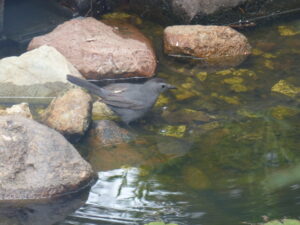
-
A catbird drinks by a pool.
-
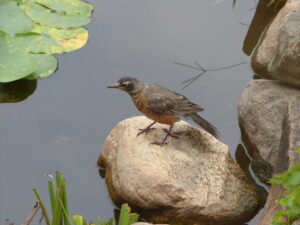
-
Keeping a wary eye, the robin cautiously gets a drink.
-

-
Hummingbirds zoom up, down, and sideways all summer. Then, head south.
-
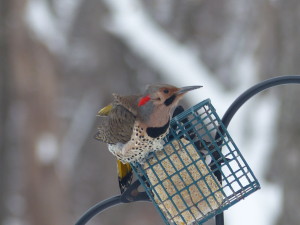
-
Winter is tough on birds so keep your feeders full.
-
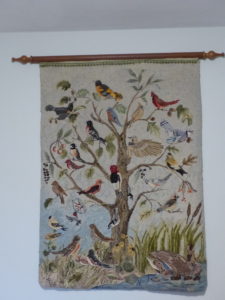
-
A hooked rug by Yvonne Fellows
Modern Technology Helps
Identifying flower and bird species is a fun activity that modern technology has made relatively simple. We use phone apps to help identify plants and birds. Many are free.
Plants: SEEK is amazing. SEEK is part of an electronic world called iNaturalist. It works for many domestic plants as well as wild ones. Load the app, open it when encountering an unknown plant, take a photo, and SEEK can usually accurately identify it.
Birds: We love the Cornell University Lab of Ornithology’s Merlin Bird ID app. It includes a sound identification tool. So, when we’re in the woods, prairie or marsh and we hear birdsong we can’t identify, we turn on Merlin and select the sound feature. It identifies what’s singing. Merlin also includes photos and information on each species.
We hope you take in the annual show. Early May is the best time to be outside. Enjoy and remember.
by Winding Pathways | Dec 26, 2024 | Flowers/Grasses, Trees/Shrubs
Historic Background and Reason For Prescribed Burning
After the glaciers retreated over 9,000 years ago fires swept across much of North America, set by Native Americans and occasionally started by lightning. Fire created the vegetation and wildlife Europeans found during settlement and westward expansion.
Europeans disdained and feared fire. They suppressed it while introducing many invasive exotic plants. This has created a forest landscape of large trees with an understory of shade-loving exotic vegetation in place of former savannas.
Europeans didn’t understand nor appreciate varied ecosystems like prairies. Even as farmers and ranchers used the open lands for crops and grazing, little did they realize the importance of fires. Fires sweeping across prairies invigorate grasses and wildflowers while killing any brushy plants that try to move in.
What Fire Favors:
- It tends to favor grasslands over forests.
- It tends to create and maintain savannas.
- It tends to favor native over exotic vegetation.
- It tends to favor some native tree species over others. In general, trees that produce large nuts, such as oaks, hickories, and walnuts tend to be fire-resistant or dependent. Trees that create small seeds, such as elms, ashes, and maples tend to be fire-tender. The impact of repeated fires shifts dense woodlands to savannas dominated by oak and hickory and, in drier areas, prairies.
-
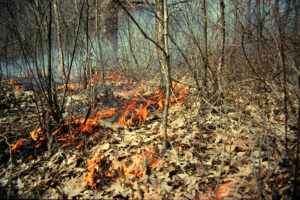
-
A cool forest burn
-
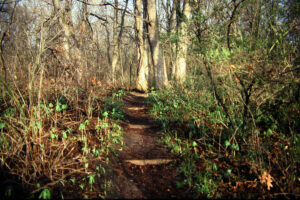
-
Burns open up sunlight for spring ephemerals.
Impact of Prescribed Burns on Prairies
Prescribed burning tends to:
- Remove insulating dead grasses, allowing the sun to warm the soil. This, favors warm season prairie plants.
- Create ash, which enriches the soil by recycling nutrients.
- Stimulate native species.
Note: burning in fall tends to favor forbs (wildflowers) while early spring burning favors prairie grasses.
Safety for Persons Conducting Burns
- Have a fire permit and adhere to its requirements.
- Wear natural fiber clothing, leather gloves, and sturdy boots.
- Understand fire behavior. See below.
- Stay out of unburned fuel and know where safe locations are. Safe locations include already burned areas, paved or gravel surfaces, and mowed lawns.
- Understand a clear burn plan as presented by the coordinator and follow directions.
- Be aware of where all people are during the burn.
- Have a cell phone with the number of the fire department programmed in.
- Have appropriate fire management tools handy and a first aid kit.
- Know about how to survive should one be “caught” by a fire.
- Be aware of “defense in depth”. (Have a second location to hold a fire should it get out of control.)
-
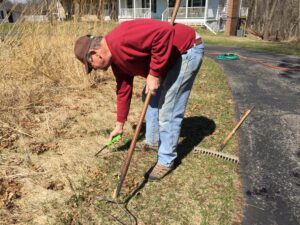
-
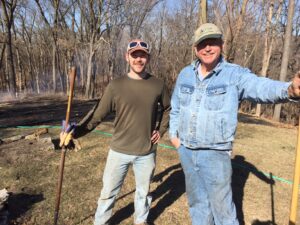
-
Mentoring younger fire managers.
Fire Behavior
Fires behave based on three factors: Fuel, Topography, and Weather.
Fires tend to burn faster:
- Upslope rather than on the flat or downhill.
- With the wind.
- With low humidity.
- With dry fine fuel.
Knowing these tenets of fire behavior helps plan burn strategy. For example, if the humidity is low, wind is moderate, and fuel is dry and fine it may be prudent to burn slowly into the wind or downslope. However, if the humidity is high and the wind is low it is likely prudent to burn with the wind, after creating a safe firebreak. These assume flat terrain.
-
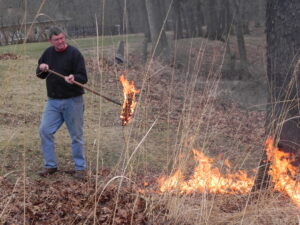
-
Rich moves fire to new fuel.
-
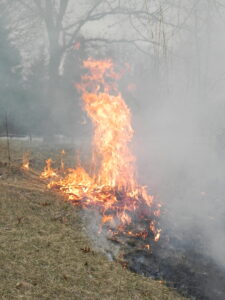
-
Burn Against Wind
A skilled person planning a prescribed burn considers all these factors before striking a match and conducts the fire most prudently.
Conducting a prescribed burn is one of the most effective ways to restore a semblance of America’s traditional vegetation.
-
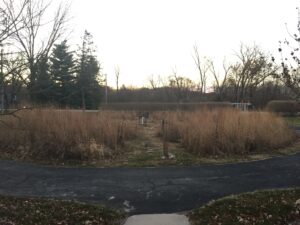
-
Pathways and prairie grasses.
-
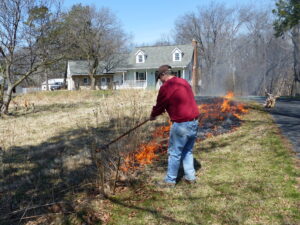
-
Stand out of fuel.
-
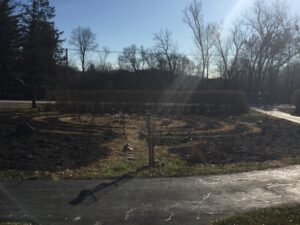
-
Dark soil warms the earth.
by Winding Pathways | Dec 12, 2024 | 1080 Labyrinth Blog, Flowers/Grasses, Garden/Yard, Labyrinths
Humidity makes a huge difference when it comes to fire. So does the wind.
On mid-morning December 3, 2024, two Cedar Rapids Gazette reporters and a photographer arrived at Winding Pathways to experience a prairie burn. We’d set the date ahead of time, hoping burn conditions would be ideal. They weren’t, but we decided to give it a try.
The humidity was around 75% with barely a puff of breeze.
We aimed to burn our backyard prairie to reduce brush and encourage next year’s wildflowers. With low humidity cured prairie grass burns almost explosively, sending flames towering above the ground.
On the high-humidity morning, we struck a match and started an unenthusiastic fire that crept along the ground and only burned hot a few times. Then it died all by itself. We called it a day.
-
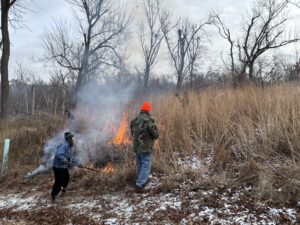
-
Olivia and Rich
-
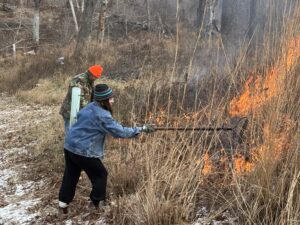
-
Learning to pull fire.
-
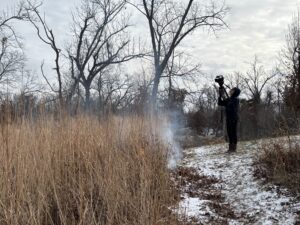
-
Photographer filming
Three days later we tried again under very different conditions. The humidity was down to about 40% and a pleasant and steady southwest wind blew at around 10 miles an hour. What a difference! The fire roared across our prairie, consuming grass it had ignored three days earlier. Marion lit the prairie around her labyrinth and it also roared.
-
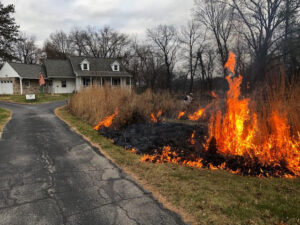
-
Low humidity burn
-
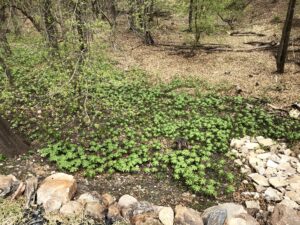
-
Fall burns allow forbs to grow.
Dry grass is especially sensitive to changes in humidity. When humidity rises grass quickly absorbs the dampness. When humidity drops, grass sheds moisture just as quickly and is ripe to burn. Wood does the same thing but much slower.
Our burning is now over for the year. We know it will stimulate an amazing array of colors next midsummer when wildflowers are in full bloom.
-
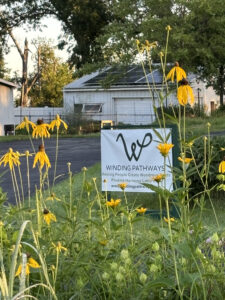
-
Colorful Flowers
-
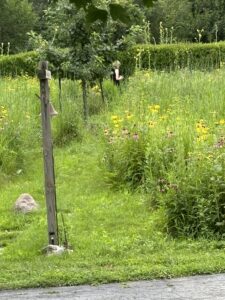
-
Colorful flowers line the path.
-
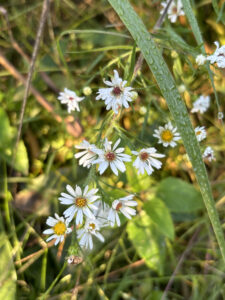
-
Prairie grasses capture moisture.
by Winding Pathways | Sep 26, 2024 | Flowers/Grasses
Serendipitous Derecho
We sat on our back deck one early September evening remarking on the delightful wildflower progression we’ve enjoyed since early April. It is the serendipitous result of a disaster.
On August 10, 2020, a derecho’s 140-mile-an-hour wind knocked down almost all the trees. That led to days of chainsawing and hauling off firewood and brush. A few trees survived, but land that had been shady for decades was now in either partial or full sunlight.
What a change the storm made by transforming shade to sun! We planted some wildflower seeds, but the huge resurgence of flowers came from seeds that had remained dormant in the soil…..the seed bank … ..for years waiting for the right conditions to sprout.
-
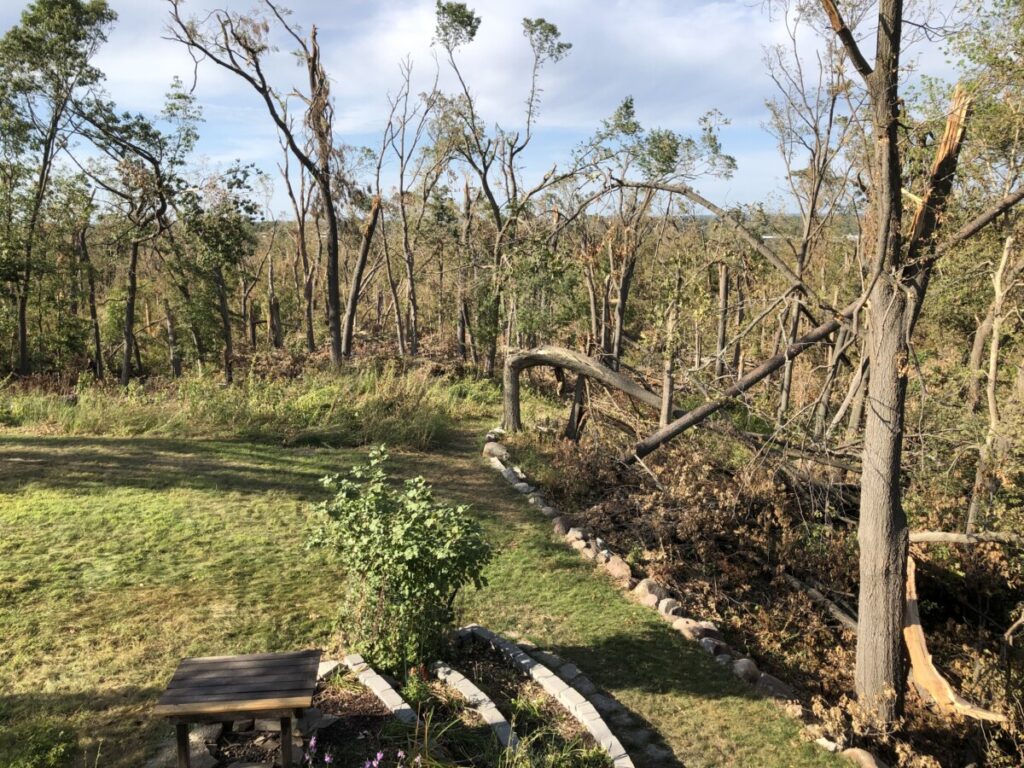
-
The once shady hillside lay exposed to the sun.
-
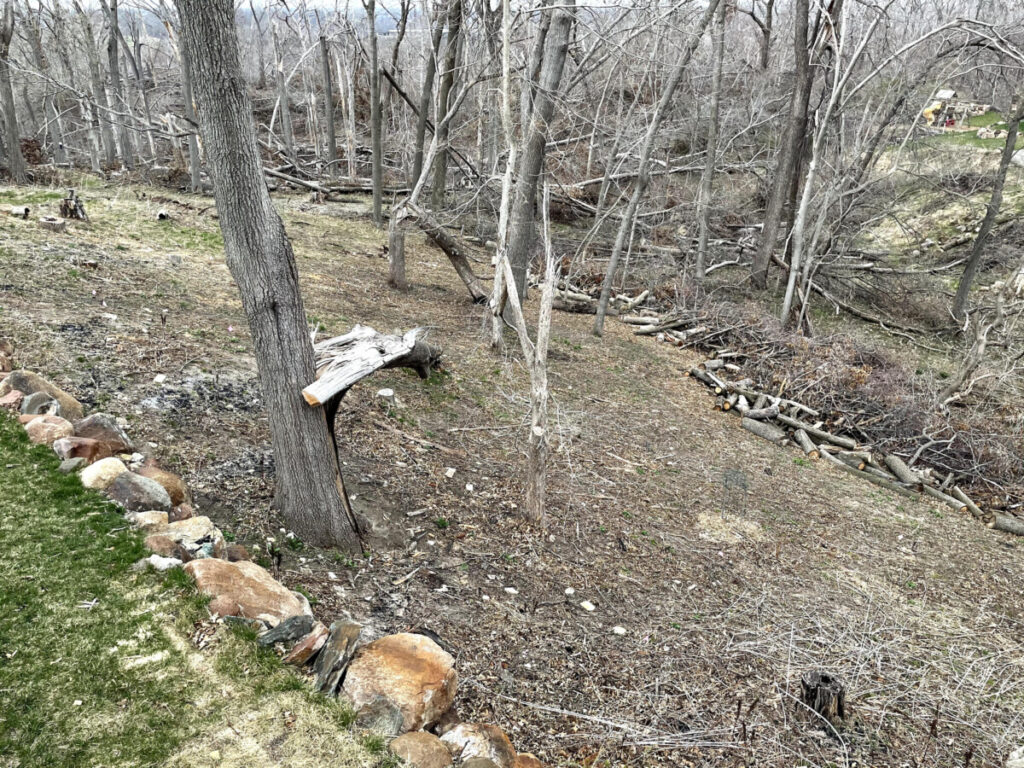
-
Bare hillside
This Growing Season
April: Spring ephemeral flowers appeared. Anemones, spring beauties, Jacob’s Ladders, ginger, and bloodroot bloomed. They are called ephemerals because they don’t last long and soon disappear.
May: Our entire former forest was carpeted with toadstool-shaped May apples. Many sprouted beautiful white flowers that are, unfortunately, mostly hidden under their large leaves. After they fruited the plants faded away to be replaced by summer bloomers.
June, July, and August: Summer flowers added color. Pale purple, yellow, and purple coneflowers and woodland sunflowers bloomed amid thriving big and little bluestem grasses. Unlike earlier flowers, these stay in bloom for several weeks.
September: Goldenrod began blooming around the first of September and was soon joined by a fresh snowfall!!!!! Well, it wasn’t really snow, but so many white snakeroots came into bloom that our former woodland looked like newly fallen snow with golden sunflowers mixed in.
White snakeroot!
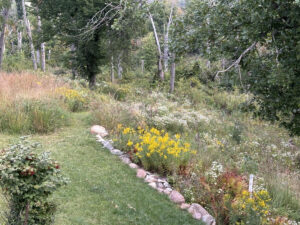
The hillside glows with goldenrod and a snowy carpet of snakeroot.
It’s toxic to most mammals and once killed people, but we’re not worried. If we had a grazing milk cow she might eat snakeroots and ingest a toxic alcohol that she’d void through her milk. Years ago, people drinking her milk may have sickened or died. It’s not a problem today since cows generally don’t graze in woods, pasteurization drives off the alcohol, and store-bought milk is usually a blend from many cows. So, without worry, we enjoy our snakeroot.
We are enjoying the progression but know it won’t last. Young oaks, hackberries, black cherries, and hickories have sprouted in the area. Someday, probably long after we’ve departed, our area will again be a shady woodland.








































